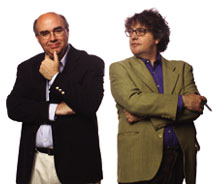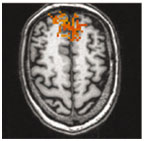September 10, 2003: Features


A
poem in the science lab
Odd
couple: For the sake of art and science, a new collaboration
By Lolly O’Brien
Warren S. Warren, a Princeton chemistry professor, doesn’t often get letters about his work from poets. So when such a letter arrived from Scottish poet Robert Crawford, the scientist was intrigued.
Crawford, of St. Andrews University, was pairing scientists and poets around the world, in the hope that when the poets were exposed to the complexities of modern science, they would create art about science. Warren, a chemist and physicist whose work usually focuses on pulse-shaping lasers, not pulse-stimulating literature, signed on. He was paired with Princeton professor Paul Muldoon, who this year won a Pulitzer Prize for his book Moy Sand and Gravel (2002).
|
Headline photo, Warren S. Warren, left, and Paul Muldoon. Below, images from a conventional MRI. The lower image shows a slice located at the position of the yellow line, at top. Red dots in the lower image show the areas of the brain that were more engaged when a volunteer read Muldoon’s poem, versus bureaucratic text. Once I Looked Into Your Eyes Once I looked into your eyes and the only tissue I saw through was the tissue of lies behind everything you do. Once I looked into your heart and imagined I could trace the history of the art of deception in your face. Now there’s something more than a chance of making molecules dance I'm somewhat gratified to find that by laser-enhanced magnetic resonance, if nothing else, I may read your mind. By Paul Muldoon
|
The results of their collaboration included a new poem, “Once I Looked Into Your Eyes,” and a clear illustration of how the human brain responds when presented with emotive material such as poetry.
The collaborators had never met before the project brought them together, more than a year ago. Suddenly Muldoon, who had not been in a science lab since he was a teenager, was visiting with Warren and learning about lasers, magnetic resonance systems, and other sets of instrumentation used in laser spectroscopy and materials imaging.
An admirer of the metaphysical poet John Donne, Muldoon came away from his visit to Warren’s lab a bit awed. He couldn’t help wondering what he had gotten into. “Frankly, I didn’t really understand what was going on,” he says, “and I didn’t know exactly what to do, partly because the
material was so difficult, partly because one is always slightly skeptical of writing to order.” But several weeks later, Muldoon sent his sonnet, “Once I Looked Into Your Eyes,” to Warren. In his poem, Muldoon imagines what could happen if we were able to apply magnetic resonance imaging to a beloved, and see the molecular makeup of lies and deceit.
The next part was up to Warren. “I was extremely impressed with the poem,” says Warren. “I was then commissioned to write a reply to the poem, to report if the poet had actually gotten it right or even if it made any sense at all. Not being a total idiot, I decided I wasn’t going to try to write poetry in response to Paul Muldoon, so I had to think for quite a while about what would be the correct way to come up with something reasonable. And then it occurred to me that we could do what turned out to be a really cute experiment.”
Warren, whose research often involves brain scans, decided to use the tools in his lab to see if he could document the effect of Muldoon’s work on the brain of an anonymous test subject as the subject read the poem. Warren had his test subject stop reading after each stanza and switch to text used by the registrar’s office about how to manage seating for a final exam.
The results of the brain scan clearly show a marked difference in the brain’s physiological response between the times when the subject was reading the poem and when he was reading the registrar’s instructions. The prefrontal cortex, the seat of reasoning and emotion, is visibly more engaged when dealing with the complexities of poetry than with straightforward bureaucratic prose. (Warren’s full written response can be seen by clicking here)
This result was no revelation to Warren, former director of POEM (an opportune acronym for the Center for Photonics and Optoelectronic Materials), who has a laser lab in the radiology department at the University of Pennsylvania where he researches the medical implications of various forms of molecular imaging. “The prefrontal cortex activation is not a surprise. You would expect the poem’s language, which is sharp and has emotional impact, to engage the brain very differently than would banal language in an ordinary text.”
Last May, Warren and Muldoon presented their work at St. Andrews to 80 people, mostly humanists. Their presentation was the last of the reports by nine pairs of participants, including poets Michael Donaghy, John Glenday, and Sarah Maguire, and scientists Rona Ramsay, a biochemist; Martin Conway, a psychologist; and Kevin Warwick, who specializes in cybernetics. Oxford University Press plans to publish a compendium of the results of this project, which was sponsored by the Wellcome Trust, a private British organization devoted in part to scientific education of the public.
Crawford, who uses scientific and technological imagery in his own poetry, praises all of the presentations for provoking discussion. “Poetry, like science,” he says, “is normally something that involves some form of publication, and some of the discoveries in the project, for example the similarities between the work of a solar physicist and a poet — a balancing of dream, technical precision, and awe — came from preparing and participating in the public discussions.”
One of the points of the project, says Crawford, was to see what would happen when the participants were “pushed through a doorway” and exposed to new fields. When the project concluded in May, Crawford recalls, “I think each participant felt a certain validation by realizing that his or her medium or discipline might be valued by someone working in a very different field.”
The project prompted Warren to be more aware of the humanist side of things. “We’re sitting over here,” says Warren, in his office in Frick, “and there’s an extraordinary number of brilliant humanists over there,” pointing to the central campus, where most of the humanities departments are housed. “We don’t find the time, in general, to get over there, and they don’t find the time to get over here.
“For society as a whole, that’s a problem. It is true, and it will be even truer so over the next few decades, that the results of scientific investigations are going to have far, far more than scientific implications, such as advances in weapons technology, human cloning, the correction of so-called defective genes in utero, and others. How do people in the humanities join in the debate if they don’t really have any idea of what’s going on in the laboratory? And how do the scientists really join in the debate if they don’t understand the ways these issues are traditionally phrased?”
Since their experiment, both poet and scientist have reflected on the similarities and differences in their work. “For the scientist the ultimate sentence is the equation. An equation doesn’t have multiple meanings,” says Warren. “A good poet tries to write things that have multiple meanings. Poets draw some on the experience of other writers, but it’s usually not just a continuation, whereas the vast majority of science is a continuation of what has been done in the past.”
Muldoon, however, believes equations also have a place in poetry. Poetry, he says, “is not necessarily about making constructs that mean several things at once. What one actually is aiming for is in some sense an equation — something that is equal to the world. That is, it operates under some terms that might ordinarily be called scientific. As in structural engineering, a poem is an object that has to survive, and withstand various stresses in the world. So in many ways it’s not so different as one might imagine.”
Muldoon reflects for a moment, then says that while he finds today’s
science hard to grasp, contemporary poetry can be equally complex. “I
don’t see why people are so surprised, actually, that modern poetry
is so difficult. They’re not surprised when modern science is.”
![]()
Lolly O’Brien is managing editor of PAW.


